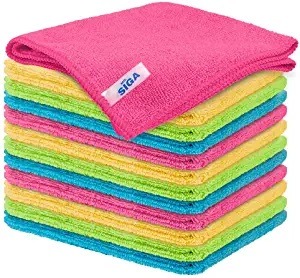Kitchen cloths and sponges do a great job as cleaning tools. Nevertheless, just like any other reusable item, they become wet and dirty from their repeated usage.
At this point, it is unhygienic to use due to the accumulated germs and bacteria that can cause contamination.
In addition to accumulating dirt and bacteria, dirty kitchen cloths and sponges can be a source of foul smells. There is no doubt that everyone wants a fresh smelling kitchen.
The sponges which are often wet can end up feeling slippery and unpleasant to touch.
Cleaning tools also require cleaning. Maintaining cleaning tools is equally important, like any other cleaning chore.
Washing your dishes with a dirty sponge will make it ineffective in its job. Moreover, your utensils are as clean as the cloth you use to wipe them.
Cleaning and maintaining these tools is an effortless but necessary task. This article highlights the procedure you can follow to ensure your kitchen cloths and sponges are always clean and well maintained.
Kitchen cloths
There are various ways of cleaning your kitchen clothes. These include washing with a machine or hand washing.
Washing machine
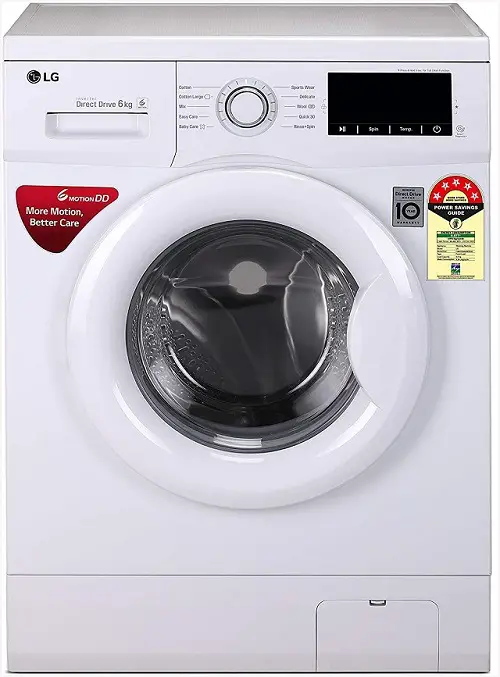
Kitchen cloths require regular cleaning as they harbor numerous bacteria and dirt. For the dirty cloths, wash on the hot water cycle to destroy any germs present in them.
For white cloths, use a detergent with bleach while for colored cloths, use peroxide soap. Let the machine operate similar to a normal laundry cycle.
Clean the cloths separate from the rest of the laundry to avoid food particles and dirt from the kitchen cloths getting into your other laundry.
Furthermore, the high temperature used for cleaning kitchen clothes may damage your clothes depending on the laundry.
Hand washing
If your kitchen cloths are filthy and slimy, pre-soak it in cold water with a home bleach and detergent.
For those whose kitchen cloths that are not as dirty, this step may not be necessary. Wash the cloth till there is no more stain or dirt left.
Give your cloth a thorough rinse. Squeeze out all the excess water over the sink before you can dry it.
Drying
Dryer
You can opt for the use of the machine dryer. Set the dryer to the hot setting as well. Allow the dryer to operate like normal. The high temperature also kills any remaining bacteria.
Avoid mixing the kitchen cloths with other clothes in the dryer. The high temperature may cause some fabrics to shrink.
Run each cloth in the dryer until it is totally dry. Wet cloths can easily attract bacteria. A dry towel will have all the bacteria eliminated as well as minimal chances of attracting germs.
Sun-drying
Alternatively, you can also hang the kitchen towel out to dry in a sunny place. If it’s in your kitchen, find a place where the sun rays penetrate your kitchen and lay it flat to dry.
If the sun does not reach your kitchen, just lay it flat or hang it somewhere clean in the kitchen for faster drying.
Do not hang the cloth next to the sink. The sink area is full of bacteria that may contaminate your cloth.
Storage
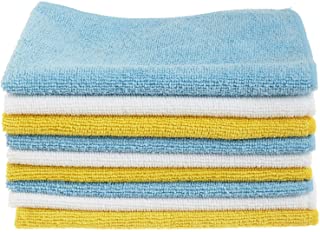
Always store your cloths in a clean, dry place after the whole cleaning and drying process is complete. Let the cloths maintain that condition until you are ready to use them.
You can select a dry drawer or cabinet to store your towels. Also, it is not advisable to store your towels while rolled up.
Kitchen Cloth Maintenance Tips
Kitchen cloths can absorb foul odors due to dampness, bacteria and surrounding smells. The smell may remain on the cloths even after washing.
Below are some tips to guide you through the proper maintenance of your kitchen cloths:
- Wash the cloths on a daily basis. Air-drying should never be a replacement of the thorough washing of the cloths as the cloths can still attract bacteria.
- Soak the cloths in a bucket with warm water, vinegar and baking soda for a quarter an hour to absorb the smells. For the white cloths soak them in a detergent with bleach.
- Ensure your kitchen is clean and fresh. The kitchen cloths tend to absorb moisture and odors from the atmosphere.
- Boil them in hot water every once a month to eliminate bacteria and odors.
- If you are using a microfiber cloth, ensure you wash it after every use.
- For drying dishes, always use a clean cloth.
- In several instances, use a paper towel as an alternative. For instance, to wipe off grease or soak up excess moisture from the meat.
- If you are planning on cleaning the kitchen cloths, store them in a sealed container to prevent the spread of odor.
- Should you use the clothes to wipe off spilled dairy products like milk or yoghurt, wash them thoroughly thereafter since any remnants of sour milk will give your cloths a sour smell.
Kitchen Sponge Cleaning Tips
Always clean your sponge several times within the week. Dampness and dirt can cause the growth of bacteria and bad smells. There are three ways to clean your sponge;
Dishwasher
For the sponge, put it in with a normal cycle in the dishwasher. The high temperature will destroy all the bacteria and germs.
Hand washing
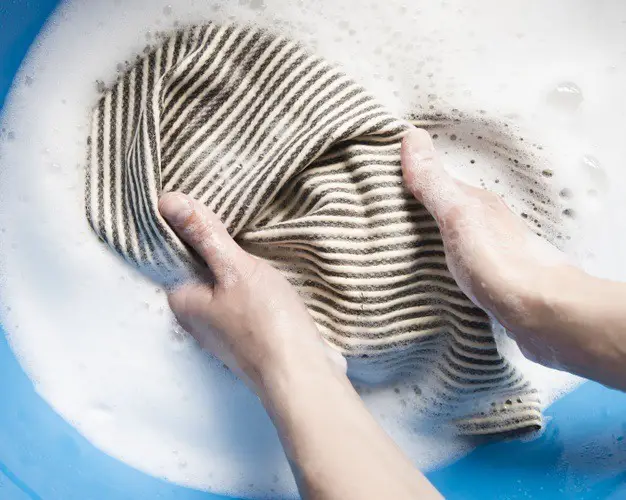
Use hot water with an anti-bacterial detergent. Use your hands to work the solution into the sponge. Rinse the sponge with clean water.
Afterwards, soak it in a weak solution of bleach, that is a solution of diluted bleach, and allow it to stay for an hour. You can then give your sponge a final rinse.
Microwave method
In this method, place your damp sponge in the microwave. Have it on a high setting and let it run for two minutes. Ensure there is not even the slightest metal present in the sponge.
Also, make sure the sponge is wet enough lest it will burn in the microwave. When taking it out, take caution as it is still very hot.
High temperatures in the microwave will kill the bacteria and germs in the sponge.
Kitchen Sponge Maintenance Tips
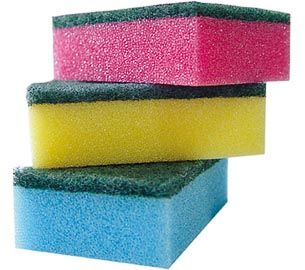
Lack of proper maintenance of your sponge may make it filthy due to the nature of its work.
Moreover, it may be harmful to your health as the sponge can contaminate your food and dishes as well. Below are ways to ensure that your sponge is safe for use.
- Rinse and wring out as much water as possible before storing.
- Clean your sponge every day.
- Store in a small sponge rack and not close to the sink due to contamination and dampness.
- Opt for a microfiber sponge as it dries out quicker.
- Do not use the sponge for too long. Replace the sponge after 2 weeks to 1 month of using.
- Do not mix up the roles of the kitchen cloth and sponge.
- In cleaning the butcher blocks, use a paper towel instead of the normal sponge you use on your dishes because of the absorption of strong odors.
How to clean kitchen sponges
Yes, you’ll find different ways of cleaning a sponge, and you certainly should.
The manner of cleaning will vary depending on various factors, such as the material the sponge is made out of, to the frequency of its use, the amount of dirt or slime on it, your preference on cleaning products etc.
The frequency varies depending on how frequently you clean dishes; however, the best target to aim for is once every 3 to 4 days.
Below are tips on how to clean a sponge:
Set the washer to the hottest possible setting and put in a sponge with some bleach-based solution. Run the washer at 60 degree Celsius.
Make sure you soak the sponge in bleach in your sink. You can use this method to clean a kitchen sponge. Just fill the sink with four liters of water and ¾ cup of bleach and soak a sponge in it for 5 minutes.
Use dish soap to lather the sponge and then use hot water for flushing. This works to get rid of bacteria from the surface. Ensuring that the sponge is still damp, place it in your microwave.
After that, heat it on high temperatures for 2 minutes. It is important that you ensure the sponge is wet, as a dry one can catch fire in the microwave.
If you opt for this sponge cleaning method, you have to stand close by while it is in your microwave.
The do’s and don’ts of cleaning a sponge
So, what should you do? Acquaint yourself with the information about cleaning a dish sponge.
This will likely reduce the chances of spreading disease-causing germs to your loved ones and friends.
Do rinse and dry before you store
You already know how wetness and food bits allow for the growth of disease-causing germs. Take measures to hamper their growth by rinsing the kitchen sponge properly after you clean.
Once this is done, you will want to squeeze as much water from your sponge as you can.
After that, store your sponge in a place where it will dry entirely, such as a small sponge rack, instead of the sink’s bottom part.
Do clean a sponge every day
Clean dish sponges reduce your chances of spreading microbes around the kitchen. One of the most effective methods of cleaning up a sponge is microwaving.
Just put an entirely damp sponge in the microwave for less than 2 minutes, watching over it while your microwave is on. Allow it to cool before you take it out.
In addition, you can wash the sponge in your dishwasher, with the dishes, provided that you use a heated dry setting.
Do use microfiber sponges
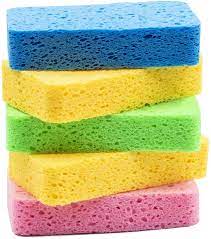
When you are shopping for a new sponge for cleaning the dishes to replace the worn-out sponge, think about microfiber.
While many sponge manufacturers make no claims that microfiber minimizes microbes, the material’s composition lends itself to dry fast. This means a microfiber sponge might not stay wet after you use it as long as cellulose sponges will.
So, the time where bacterial should develop might be cut shorter. A microfiber sponge is easy to get either in your local store or online. They are also affordable.
Do not use dishcloths in lieu of clean dish sponges
Some people might prefer a dishcloth to a sponge. There are a few issues with this. To start with, a dishcloth does not dry out as fast as a sponge, so it might probably grow bacteria more.
Also, most people do not wash their dish cloths regularly. If you are using dish cloths in place of clean sponges, you should replace or wash the cloth regularly.
Do not keep a sponge too long
Do you always keep kitchen sponges for too long such that they begin smelling bad? That is the odor of a pleased bacteria colony flourishing on the very thing you use for cleaning up the dishes and countertops.
If you are cleaning up a cellulose sponge every day, you might get roughly 14 days’ use out of it. A microfiber sponge that’s cleaned up frequently may last for up to one month before you replace it.
Do not use a sponge on cutting boards
Since you prepare raw meat using cutting boards and butcher’s blocks, they are more susceptible to housing microbes.
Never use your daily counter and dish washing sponge to clean these things. Rather, use a bleach wipe or paper towels with disinfectant recommended by the manufacturer.
If you end up using the sponge for wiping meat juices, you will most likely need to dispose of it right away.
When you pick up that sponge in your kitchen, ask yourself how long it has been since you changed or cleaned it.
Now that you know of the do’s and don’ts, and also some kitchen sponge pathogens facts, you can keep the kitchen healthier and cleaner.

